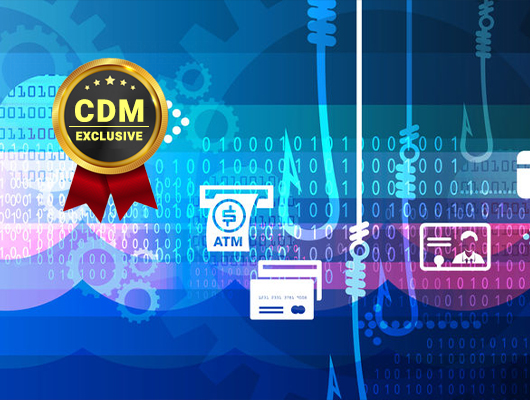ARTIFICIAL INTELLIGENCE POWERS VOICE BIOMETRICS FOR A MORE SECURE, FRICTIONLESS CUSTOMER EXPERIENCE
By Brett Beranek, Vice President and General Manager, Security, and Biometrics, Nuance Communications
A growing number of organizations are deploying biometrics for a simpler, more secure way for customers to validate their identities and do business with your organization. These emerging technologies, often powered by artificial intelligence, not only help to combat near-constant attacks by hackers, but they also provide your customers with high levels of security and convenience.
Social disruptions, such as a global pandemic, produce new realities that create paradigms in myriad areas of life. That can mean accelerated transitions into new ways of living, from permanent work-from-home arrangements and telehealth to remote schooling and virtual socializing. Simultaneously, these digital behaviors are opening new doors to hackers and fraudsters, who remain ready to capitalize on any vulnerabilities, chaos, and uncertainty.
For example, Nuance has learned from its customers that the volume of fraud attacks is on the rise – ranging from 200% – 400% in the past few weeks, depending on the industry. Some of these relate directly to the pandemic, with recent reports1 suggesting there have been at least 500 coronavirus-related scams and over 2,000 phishing attempts so far. This figure is only set to increase as time goes by. These crimes come with a hefty price tag, costing the global economy more than $5 trillion annually2.
Fraud is preventable
Your first line of defense often means reminding your customers to use unique passwords not replicated on other sites, to enable multi-factor authentication, and to establish challenging questions to verify identities in the case of a forgotten password. As long as passwords are the first line of defense, then fraud losses will continue increasing year-after-year as it has for the past two decades. Fraudsters will leverage the tried-and-true methods of phishing for passwords, or leveraging the password reset process (e.g. OTP SMS or security questions) to perpetrate their fraud. I recently interviewed a fraud victim, Rob Ross, who lost over $1m because of this OTP SMS password reset mechanism alone. As an industry, we need to definitely put a big red X on passwords, password reset processes, and OTP SMS mechanisms if we ever stand a chance to start reversing the trend and see decreases in fraud losses.
Server-Side biometric authentication and fraud prevention solutions offer a new line of defense
Server-side biometrics modalities such as voice biometrics have proven hyper-effective at eliminating passwords, PINs, and security questions as authentication mechanisms in contact centers. You may have experienced yourself, maybe the last time you called your bank, that you were seamlessly authenticated this way. What you may not be aware of, is that regardless of if you authenticated this way or not, voice biometrics was also used to detect fraud on all incoming calls. This is the benefit of an integrated approach to using biometrics for both fraud prevention and authentication. Organizations have reported phenomenal results when this approach is taken; For example, HSBC reported over $500m in reduced fraud losses in 2019 due to this approach3.
How is it that contact centers have become, in many cases, more innovative than digital channels such as mobile apps and websites when it comes to authentication and fraud prevention? One explanation is in the easy access to “free” device-side biometric modalities, such as fingerprint readers and facial recognition on smartphones, which unfortunately by their very design, have had no impact on fraud prevention or the elimination of passwords. At the end of the day, because these biometrics modalities are device-based, they can’t be used to detect fraudsters (no ability to create a watchlist), and they require a reset process – which is often a PIN or a password.
We have fallen into the trap of “free” and this has represented an immense gift to the fraud community. Device-side biometrics have created an illusion of increased security, which we are now paying a hefty price for.
Server-side biometrics, deployed in an integrated fashion for both authentication and fraud prevention, are an essential tool to rid ourselves of passwords, security questions and OTP SMS. Let us learn from our peers in the contact center industry and apply these technologies to all of our customer engagement channels and finally put an end to the incessantly rampant fraud scourge.
Consider a contact center environment with an integrated biometric authentication and fraud prevention solution in place. When a customer calls into the contact center, they can ditch the password and PIN and instead use the power of their voice, simply speaking the phrase “My voice is my password” to gain immediate access to their account. Biometric authentication analyzes more than 140 physical and behavioral characteristics, including the speaker’s accent and rhythm, to create a unique, individual voiceprint. In addition, the intelligence built into the authentication software can distinguish between live speakers and recordings by monitoring sound frequencies. As a result, these voiceprints are vastly more secure than conventional passwords; that is, hackers can steal a password, but they can’t steal a person’s voice or reverse-engineer it, even if they were to gain access to the voiceprint from the server.
Beyond seamless, frictionless authentication to confirm a customer’s identity, an AI-powered fraud prevention platform can engage in real-time authentication to help ensure swift and accurate fraud prevention. If a criminal were to insert him- or herself into a conversation, for example, the intelligence can quickly identify it and help to prevent financial losses. Likewise, by automatically analyzing calls in real-time, intelligent fraud prevention solutions can easily and quickly identify potential fraud cases before a crime is committed.
These solutions can help to improve your security efforts across multiple channels (interactive voice response, SMS chat, virtual assistant, and live chat) to create an efficient, intelligent, more secure customer experience. And while these solutions can help shore up your boundaries and protocols now as you adapt to and cope with a time of social disruption, they also set the foundation for a more secure future.
About the Author
 Brett Beranek is the Vice President and General Manager at Nuance Communications. He is responsible for overseeing every aspect of the security and biometric business at Nuance. Prior to joining Nuance, he has held over the past decade various business development & marketing positions within the enterprise B2B security software space. Beranek has extensive experience with biometric technologies, in particular in his role as a founding partner of Viion Systems, a startup focused on developing facial recognition software solutions for the enterprise market. Beranek also has in-depth experience with a wide range of other security technologies, including fingerprint biometrics, video analytics for the physical security space, and license plate recognition technology. He has earned a Bachelor of Commerce, Information Systems Major, from McGill University as well as an Executive Marketing certificate from Massachusetts Institute of Technology’s Sloan School of Management. Brett can be reached on our company website https://www.nuance.com.
Brett Beranek is the Vice President and General Manager at Nuance Communications. He is responsible for overseeing every aspect of the security and biometric business at Nuance. Prior to joining Nuance, he has held over the past decade various business development & marketing positions within the enterprise B2B security software space. Beranek has extensive experience with biometric technologies, in particular in his role as a founding partner of Viion Systems, a startup focused on developing facial recognition software solutions for the enterprise market. Beranek also has in-depth experience with a wide range of other security technologies, including fingerprint biometrics, video analytics for the physical security space, and license plate recognition technology. He has earned a Bachelor of Commerce, Information Systems Major, from McGill University as well as an Executive Marketing certificate from Massachusetts Institute of Technology’s Sloan School of Management. Brett can be reached on our company website https://www.nuance.com.
1The Guardian, April 2020
2Crowe Financial Cost of Fraud Report.
3Choose.co.uk, March 2020


